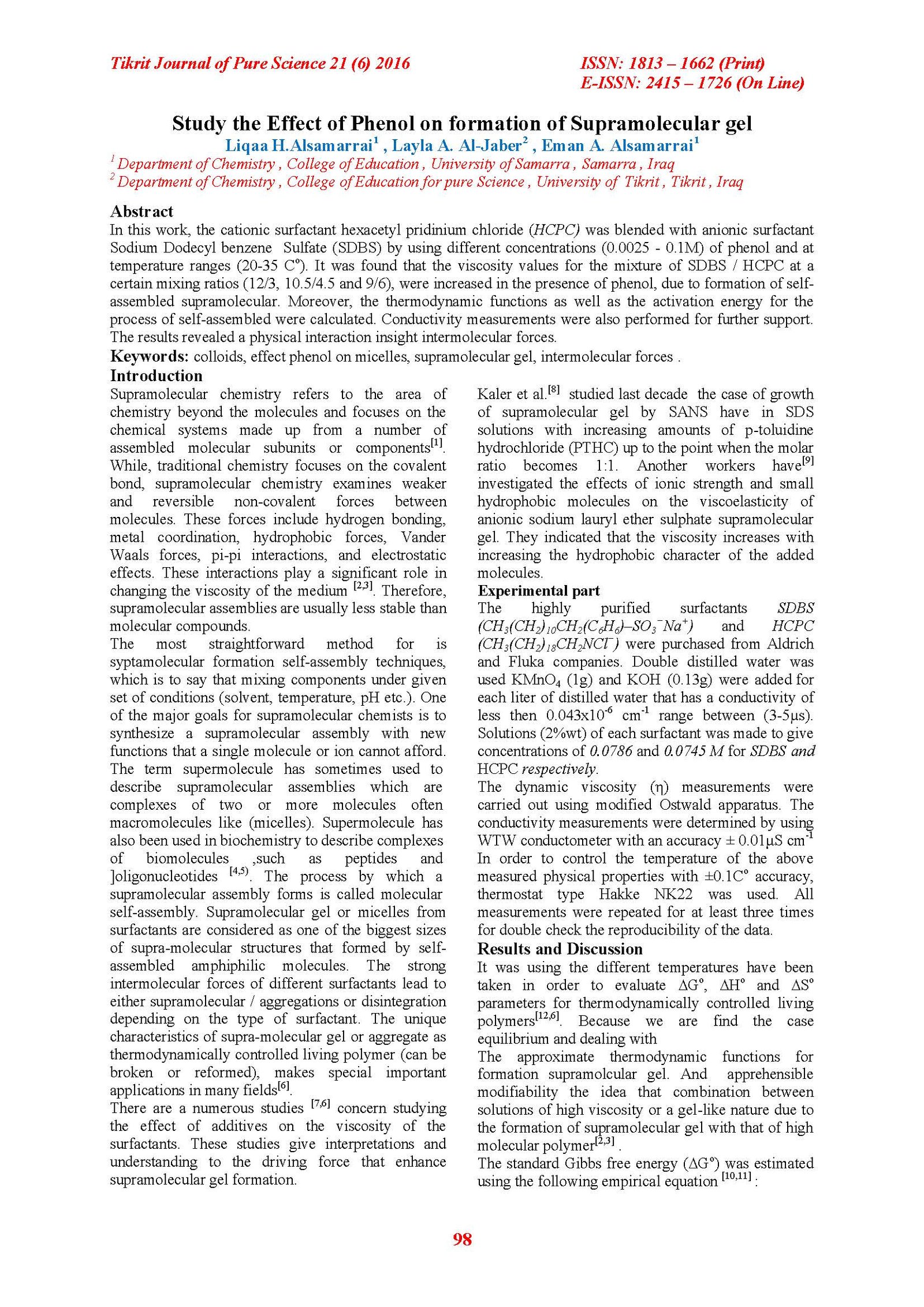Study the Effect of Phenol on formation of Supramolecular gel
Main Article Content
Abstract
In this work, the cationic surfactant hexacetyl pridinium chloride (HCPC) was blended with anionic surfactant Sodium Dodecyl benzene Sulfate (SDBS) by using different concentrations (0.0025 - 0.1M) of phenol and at temperature ranges (20-35 Co). It was found that the viscosity values for the mixture of SDBS / HCPC at a certain mixing ratios (12/3, 10.5/4.5 and 9/6), were increased in the presence of phenol, due to formation of self-assembled supramolecular. Moreover, the thermodynamic functions as well as the activation energy for the process of self-assembled were calculated. Conductivity measurements were also performed for further support. The results revealed a physical interaction insight intermolecular forces.
Article Details

This work is licensed under a Creative Commons Attribution 4.0 International License.
Tikrit Journal of Pure Science is licensed under the Creative Commons Attribution 4.0 International License, which allows users to copy, create extracts, abstracts, and new works from the article, alter and revise the article, and make commercial use of the article (including reuse and/or resale of the article by commercial entities), provided the user gives appropriate credit (with a link to the formal publication through the relevant DOI), provides a link to the license, indicates if changes were made, and the licensor is not represented as endorsing the use made of the work. The authors hold the copyright for their published work on the Tikrit J. Pure Sci. website, while Tikrit J. Pure Sci. is responsible for appreciate citation of their work, which is released under CC-BY-4.0, enabling the unrestricted use, distribution, and reproduction of an article in any medium, provided that the original work is properly cited.
References
[1] Lehn, J.M.,"Supramolecular Chemistry: Concepts and Perspectives", Wiley-VCH.
[2] Cook, T. R.; Zheng, Y.; Stang, P. J., Chem. Rev. (2013), 113, 734.
[3] Pham, Tuan Anh; Song, Fei; Nguyen, Manh-Thuong, "Self-assembly of pyrene derivatives on Au+3: Substituent effects on intermolecular interactions". Chem. Commun 50, (2014), (91):14089
[4] Rosen, Milton J.. Surfactants and interfacial phenomena. Hoboken, NJ: Wiley - Interscience, (2004) .
[5] Steed, J.W., Structure & Bonding,. Molecular Containers: Design Approaches and application, (2004), 108, 97-168.
[6] Khalil, R. A. and Saadoon, F. A., J. Saudi Chem. Soc. , (2014) .
[7] Manikandan, S. and Raghavan, P.S.," NTERMOLECULAR INTERACTIONS IN PHENOL – SLS – WATER TERNARY SYSTEM" ,Int. J. Curr. Res. Chem. Pharma. Sci.. 2(12): 5-10,(2015) , p. 2348-5221.
[8] Hassan. P. A, Fritz .G and Kaler. E. W, J. Colloid Interface Sci., (2003), 257, 154–162 .
[9] Parker ,A. and Fieber, W., Soft Matter, (2013), 9, 1203.
[10] Atkins.P. W, "Physical Chemistry", 3rd Ed., Oxford University Press, Oxford, (1986), p. 628-631 .
[11] Levine, I. ,"Physical Chemistry", (2001) .
[12] Ce´cile A. Dreiss Wormlike micelles: where do we stand? Recent developments, linear rheology and scattering techniques ,J. Soft Matter,( 2007), 3, 956–970 .
[13] Da Silva. G.C, Rossi. C.G.F.T, Dantas Neto. A.A.,Dantas. T.N.C, Fonseca. J.L.C, Characterization of wormlike micellar systems using DLS, rheometry, and tensiometry ,Colloids Surfaces A: Physicochem. Eng, (2011) ,377 35–43.
[14] Samuel ,I. and Liam C. Palmer," Supramolecular Chemistry and Self-Assembly in Organic Materials Design",Chem. Mater., , 26 (1), (2014) , pp 507–518.
[15] Wenxiang Zhanga*, Guohe Huanga & Jia Weib ,"Study on solubilization capability of various Gemini micelles in micellar-enhanced ultrafiltration of phenol -contaminated waters", (2015), Vol 54, ISSUE 3, p. 672-682 .
[16] Fasina OO, Colley Z., Viscosity and specific heat of vegetable oils as a function of temperature: 35°C to 180°C. Int. J. Food Prop, )2002(, 74-738: (4)11.
[17] KIRK T. SEMPLE AND RONALD B. CAIN, "
Biodegradation of Phenols by the Alga Ochromonas danica " . (1996), 62, No 4, p.1265-1273 .
[18] Lijie Le., Xiaorui Zheng, Bingran Yu, Lipeng He, Jing Zhang, Haomin Liu, "Supramolecular polymerization induced self-assembly into micelle and vesicle via acid–base controlled formation of fluorescence responsive supramolecular hyperbranched polymers", Polym. Chem. (2016),7, 287-291.
[19] Dali Wang, Yue Su, Chengyu Jin, Bangshang Zhu, Yan Pang, Lijuan Zhu, Jinyao Liu, "Supramolecular Copolymer Micelles Based on the Complementary Multiple Hydrogen Bonds of Nucleobases for Drug Delivery",(2011), 12 (4), pp 1370–1379.
